The weather so far this year has been gorgeous. Although brisk in January and February, daytime temperatures have been quite warm for a number of weeks now, and we’ve had so little rain since January 1st (our driest start to the year on record), that winter is already a distant memory. In fact, for the entire month of April we’ve had a whopping 0.87 inches of rain. Quite honestly, it feels more like the end of June, which is probably why I keep thinking I’m falling behind in the garden, when in actual fact, I’m not…well, not too much anyway.
The Orchard
In the orchard, after an extended period of winter chill, and lack of blossom-destroying spring rains, we wondered if perhaps our fruit set would be better this season. So far it does seem to be. Of course, the orchard is still quite young, but this year looks like we may be in for a bumper crop of ‘Flavor Delight’ Apriums.
Sadly, the opposite is true of our ‘Blenheim’ apricot. I think it’s fair to say this tree is…well…dead, or about to be. The culprit appears to be bacterial canker (Pseudomonas syringae).
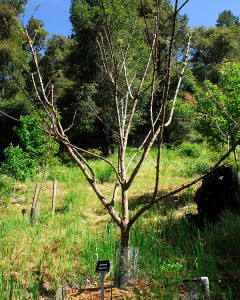
Blenheim apricots are better suited to growing further inland, and this tree has not been performing well since it was planted
We first noticed symptoms two years ago, and the tree has struggled ever since. That’s what I get for being stubborn, and trying to grow Blenheim, in an organic orchard, where it doesn’t want to grow…along the coast. To the two orchardists that advised us during the planning phase of the orchard…you were right, and I hang my head in shame.
The apples, plums, and pears have all set fruit.
Both the Indian Free, and Frost peaches are doing well.
Honestly, though, I think I’m most excited about the crab apples. It is almost impossible to find fruiting crab apple trees at local garden centers these days. I’m always told that customers don’t ask for them, as the fruiting varieties are too messy. Does that mean that Grandma’s crab apple jelly will simply become a footnote in the annals of history? Well, maybe, but not around here! This season our Wickson crab apple is setting its first fruit, and I’m especially excited to see the first fruits on my favorite Niedzwetzkyana, too!
Niedzwetzkyana is thought to be the ancestor of most modern varieties of pink-fleshed apples, including Thornberry, Surprise, and Cripp’s Pink. How amazing is the color of this fruit?!
I can’t wait to see how the fruit looks as it gets bigger this season.
Speaking of fruit, the strawberry bed I overhauled this winter is rewarding us with lush, healthy plants, that are starting to set fruit, too!
Strawberry season will be in full swing before we know it!
Cleaning Up the Kitchen Garden
The vegetable garden is what has taken most of my ‘free time’ the last two weeks, hence the paucity of recent blog posts. The greenhouse was choked with transplants eager to sink their roots into the ground.
Before I could transplant anything though, first I had to clear out the last of the winter garden, including some rather impressive looking bolted kale.
I waited as long as I possibly could to remove the kale, as each morning it was completely abuzz with honey bees, and I always feel a little guilty taking flowers away while the girls are so diligently foraging for nectar and pollen.
The kale may look pretty, but the garden overall was quite a mess.
Each raised bed was then recharged with oodles of farm-made compost before planting out our warm-season crops. I treat raised beds more like giant containers. The beds sit above grade, the soils are loose, and fast draining, and without the additional compost added to the soil each season they’d be prone to drying out too quickly on warm afternoons.
Between turkeys, chickens, goats, and all the kitchen garden green waste, we’re now having no trouble making all the compost we need on site. As our soils improve more each season, the difference is noticeable in the garden.
The Herb Beds
I amended the herb bed in January, before the culinary sage, hyssop, and thyme began to push this season’s new growth. This spring the bed looks wonderfully lush. The Oregano is already a foot tall.
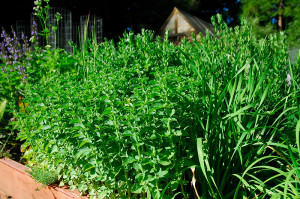
The herb bed was looking a little ragged by the end of last season, but a generous top dressing of compost did wonders
The lemon thyme is almost completely taking over…
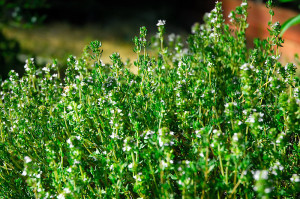
Even though the kale flowers are gone, the bees will be very happy that the thyme is starting to bloom
…and the culinary sage has never looked better, as the compost not only has improved soil moisture retention, but added a shot of extra nutrients, too.
The Genovese basil, because we use so much of it each year, gets a place of its own in the garden.
I am determined that this summer there will be a number of successional crops of basil. It’s just so easy to make and freeze pesto, that there’s no excuse for running out, and last year, we did, indeed, run out of pesto. That will NOT happen again!
One herb we’re definitely not shy on this spring is mint, both spearmint, and chocolate mint. Having grown up in England, where I think mint qualifies as a national weed that loves to run amok across small gardens, I was wise enough to plant it in half barrels.
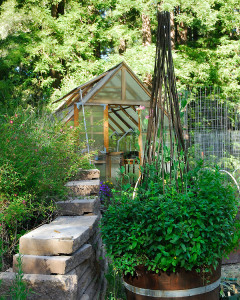
We have two barrels like this that flank the entrance to the kitchen garden, and that lush green mound is all mint!
We had one leftover French Oak wine barrel last year, like the one we split, stained, and planted by the greenhouse. Each barrel flanks the entrance to the garden, and at the moment both of them are bursting at the seams with mint…but at least the mint is contained!
The trellises in the barrels, eventually, will support some sweet peas, that are just starting to bloom, but the poor sweet peas have been struggling to grow faster than the mint, and they’re only just now getting tall enough to effectively compete for sunlight.
I haven’t grown sweet peas in years. I don’t know why. I just haven’t.
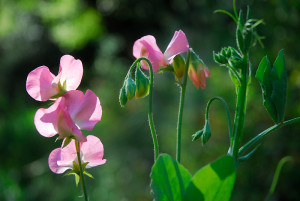
Sweet peas are a perfect flower for an heirloom garden, as they’ve been in cultivation in cottage gardens since the 17th Century!
I’d forgotten how heavenly their fragrance is! If I plant them again next year though, I should probably start them a couple of weeks earlier, before the mint bounces back after winter.
Speaking of barrels…those original barrels we stained and planted in front of the greenhouse?
Well, can you see the barrel in this picture?
Planting Out the Kitchen Garden
I admit I pushed out some of the warm-season crops a little earlier this year than usual, as our weather has been more summer, than spring-like. A couple of years ago we had one of our coolest summers on record, with a persistent coastal fog bank that was unrelenting for months. Knowing that can happen, even though it’s not typical, I figure I might as well make the most of all this glorious sunshine while we have it…just in case our ‘June gloom’ coastal fog should return again this year.
The peppers are already planted, including one bed for sweet peppers, and most of another for hot peppers.
Last season our star pepper performer was Corno di Toro, both Giallo, and Rosso, so I made sure to sow plenty of both in the greenhouse in mid-winter. Another strong performer last year was Pimento di Padrón.
Although traditionally eaten when small and green, last year our more mature red Padrón peppers were a wonderful addition to our pickled peppers. Sweet, with a little zing, they were simply perfect!
Of course the usual suspects have found their way into the heirloom tomato beds this year, along with a couple of new varieties. This year we’re trying Opalka, also known as Polish Torpedo, as our paste tomato.
We’ve previously grown Federle, and San Marzano, but our unpredictable, and inconsistent summer weather has resulted in erratic yields of both. Opalka is adapted to growing in cooler climates, so we thought it might do very well along the coast here, especially if summer is fogged in. Of course, no sooner did I plant Opalka, than our temperatures this week decided to soar into the 90s. Sort of the inverse of washing one’s car I suppose.
Our current run of warm weather, though, is ideal for the eggplants.
We had such great success with some of the smaller heirloom eggplants last year, that we’re planting many of the same varieties this year, including Little Fingers, Listada de Gandia, and the slightly larger Rosa Bianca, that made amazing grilled Baba Ghannouj last summer.
The tomatillos are also relishing the heat. We’re looking forward to a hearty crop this summer so we can once again replenish our pantry stock of tomatillo salsa verde!
This year, in addition to the classic green tomatillos, I’m also trying the smaller Tomatillo Purple di Milpa as well, so I’ll be interested to see how they grow, and taste, in comparison.
As for the cucumbers, they did very well last year, but my biggest regret was not planting enough of the pickling type. Don’t get me wrong, I love fresh sliced cucumbers for salads and sandwiches, or to make a refreshing cucumber and mint water for those hot summer afternoons, but darn it, this year I will make more pickles!
As such, I planted a plethora of the heirloom ‘Homemade Pickles’, which I’ve never tried before. Our friend Tom, at Tall Clover Farm, grew them last year, and raved about them, so we thought we’d give them a try and see how well they do for us here. We’ll report back later this season with our own results.
The last of the transplants to find their way into the garden last week included the leeks, both Giant Musselburgh, and Blue Solaise.
To prevent bolting, it’s usually recommended not to plant out celery until night temperatures are over 50 degrees. However, here we’ve had entire summers where our night temperatures still dip into the 40s, so I finally gave up waiting, and snuck the celery out over the weekend. Hopefully the weather will cooperate, and this celery won’t bolt, but we’ll have to wait and see.
Despite the warm weather, tucked away in a shadier area of the garden, hiding under a lightweight row cover, we still have plenty of lettuce and Asian greens growing. We’ve been so happy with the ‘Parris Island Cos’. Yet again, despite temperatures that would send many a head lettuce reaching for the sky, this morning these heads looked simply perfect!
The green oakleaf lettuce looks fabulous, as usual, and the Rouge d’Hiver has been no slouch this spring either. With all this warm weather, I think there’ll be at least a salad or two on the menu this week!
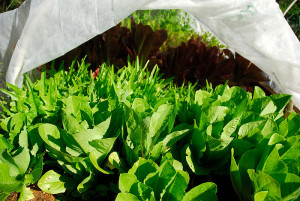
During the warmer months we grow primarily loose leaf lettuces, or romaine types, as they’re somewhat more bolt-resistant
In the meantime, the challenge is to protect some of the more tender transplants during this hot spell, at least until they get settled in. It seems strange to be watering the garden so much this early in the year, especially as some years it will rain clear through to June, but this year we’ll have to be especially careful that the gardens don’t dry out too much, as there’s not so much as a drop of rain in the extended forecast.
A couple of weeks ago I had a nagging feeling that I was behind on my planting schedule, but it is only the end of April. The garden beds have been cleaned up, the soils are amended, and almost the entire summer garden has already been planted. Where’s my hammock?!
Oh, wait, there’s just one more area to plant, the heirloom squash garden, and that’s next! Darn, I suppose the hammock will have to wait…

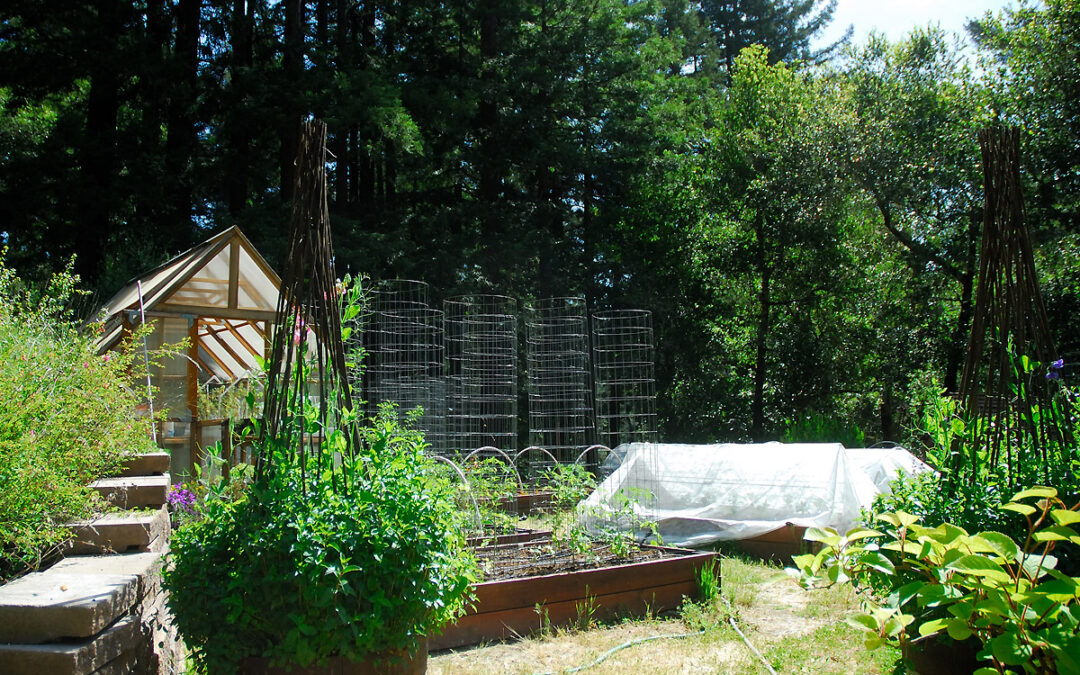
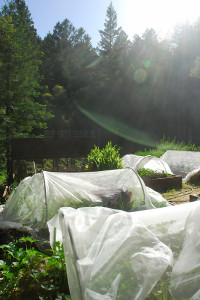
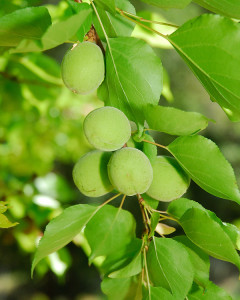
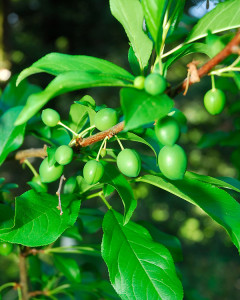
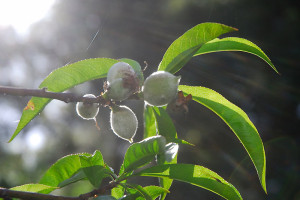

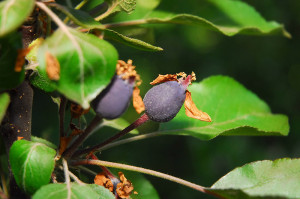
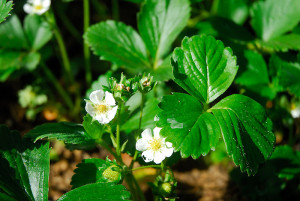
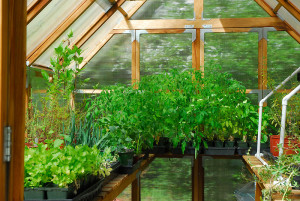
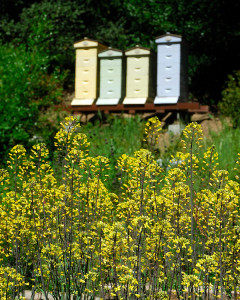

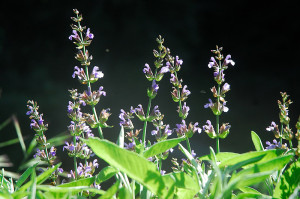
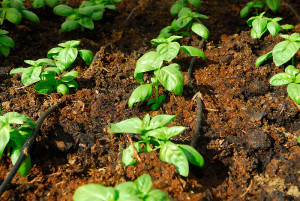

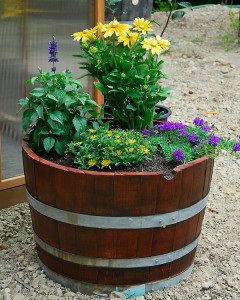
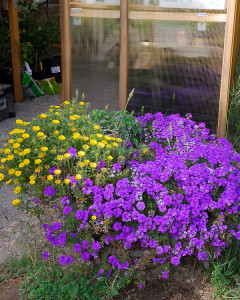
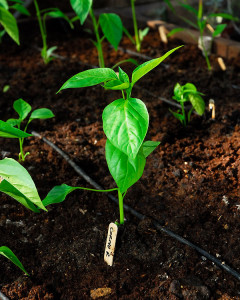
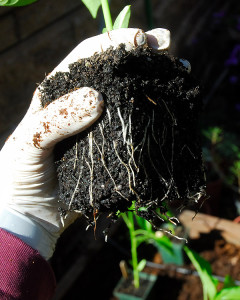

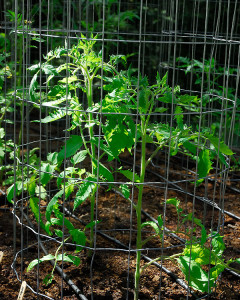
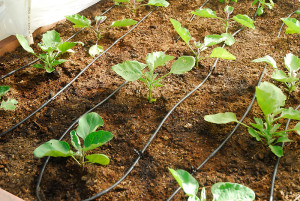
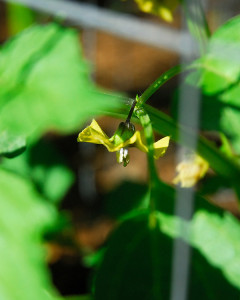



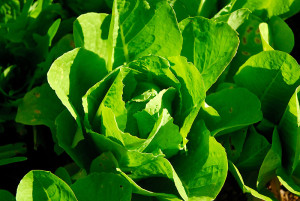
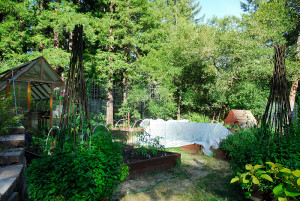







Clare, would you send me some nice chicken manure?
I’m very interested in your kitchen garden! I love planting herbs as landscape plants and can do so because the deer won’t bother them. Thyme and marjoram line my paths.
However this year we fenced an area, with three old ranch gates found here on the place for a real veg garden, so I’m soaking up all the info you’ve given here as well as some of the variety names. Ours is on a small scale, but I’m able to plant out some wintersown lettuce and spinach under the cherry tree, just inside the fence. Tomatoes next week….maybe.
Sue, have you ever considered getting chickens? Might be easier than me upsetting your postal delivery person with strange smells 😉
We use a lot of herbs here as landscape plants, sage, thyme, and rosemary especially, for the same reason. The deer don’t touch them.
I probably neglected to state the variety on a few things in this post, like the celery (Tendercrisp), however I do have the full 2013 list posted under our Kitchen Garden page, on the menu above.
We plant a lot of lettuce throughout the year here, except during the hottest part of summer. I tend to prefer the loose leaf varieties, both because they’re bolt resistant, but also because you can just harvest the outside leaves, and come back for more later. I do usually keep all of our greens under cover though, throughout summer, to prevent scorching (I just use the lightweight Agribon-15 insect cover in the warm months).
You’ve just got so much going on right now. I think you can definitely afford to swing in your hammock for a bit after all your hard work.
What a shame about apricot tree. Well done on your first crab apple fruit! That greenhouse certainly did look like it was bursting at the seams. I can understand why you waited to pull out all that fabulous flowering Kale though.
That old wine barrel overflowing with blooms looks fabulous, by the way.
The apricot tree was very disappointing. We used to live further inland, and our Blenheim apricot there grew like a weed. If we had a more exposed, and sunnier location, we might have been able to get away with one here, but unfortunately the tree just wasn’t happy here. It’s ok though, the Aprium is more than making up for it!
When I first planted out that barrel I had expected to have to replant it the following the spring. I’m amazed at how well everything comes back each year! 🙂
I am always amazed to see what is growing on the other side of the country in that warm CA sunshine (even between bouts of fog). I can imagine you have had a dry year as I just read a report on drought expectations for this year. http://insideclimatenews.org/news/20130328/drought-season-bad-start-scientists-forecast-another-bleak-year
I am reporting on it because we are in drought conditions here in Niagara Falls already. It must be tough if your area is affected because of all the fruit and vegetables that you grow on your farm. That photo of the kale and bee hives is wonderful. It tells a story even without you mentioning how the girls love the kale. I could see it in the image, even though I saw only one bee. The plant is a bee magnet.
Oh dear, those NOAA predictions aren’t very encouraging, are they? I hope it’s not going to be that bad. It’s been such a strange year…although I feel like I’ve been saying that a lot in recent years. In December we had a deluge of rain, and then it’s as if someone flipped the off switch. It’s quite odd walking out to the garden and already seeing cracks in the soil along the paths.
I think my bigger concern, even than the garden, is that a significant drought ends up driving up the cost of livestock feed so much. Last year at the end of summer our organic poultry feed jumped almost 20% in just two weeks! Hay prices will go up too, and hay quality will no doubt go down. Maybe I should stock up now…
Your garden is so healthy looking. I loved the walk through to see what was growing and the progress it had made so far this spring. The photos are very enjoyable.
Thanks for stopping by, Charlie 🙂
As we begin plotting our own orchard, I find yours very inspiring! Everything looks beautiful. Wishing you an excellent harvest this year.
I think the planning phase was the most daunting, but also the most fun. It wasn’t until the after planting that the battle with the gophers and voles began 😛 I am looking forward to finally getting some fruit out of our young orchard this season though!
I’m impressed with all you have finished. I would not feel bad about the apricot tree. Sometimes we just have to try for ourselves. And I do think that crabapple jelly will soon be a rarity (in fact, already is). I have several crabapples, but they are ornamental. I think people would ask for them, if they knew they had an option.
I was one of those kids that if I was told not to touch something, because it was hot…I’d do it anyway 😉 I don’t know how many times I was told not to bother with Blenheim apricots here. I just remembered the fruit being so good at our last place, that I had to at least try. Oh well, it’s not as if there’s a shortage of things I could replace it with. I still have all of last year’s grafted trees that need to be planted!
I think you’re right about crab apples. My local nurseries can’t even order them, as their suppliers don’t stock the fruiting varieties. The best they can do is refer you to an online specialty supplier. Thankfully, there have been at least some fruiting crab apple scions available at some of the scion exchanges we’ve gone to, and so far I think I have four different varieties grafted! It is the thing I love about having learned how to graft fruit trees, it really opens up the possibilities for what you can plant!
Clare, good for you for trying that apricot anyway. Sometimes you just never know when something might work in your favour. Isn’t it funny how crabapples have become an ornamental tree and their fruit a nuisance. Says a lot about gardeners and gardening in this day and age.
It does say a lot, doesn’t it? Don’t get me wrong, I think ornamental crab apples are beautiful, and I know why people plant them. However, here, if you’re going to occupy that much space, you darned well better produce fruit too!
What alarms me is there have been times that I’ve asked if a particular nursery stocks fruiting varieties, and I get a response along the lines of “oh no, the name is just misleading, they don’t actually fruit”. Really? Have they really become so rare that people have never actually seen a crab apple WITH fruit? So sad 🙁
SO envious of your sunshine, Clare. (Snow flurries here today and ice in my fountain,)
Awww, I’m sorry Carolyn. I do occasionally feel guilty that we’re blessed with such good weather. At least you’re getting some precipitation though. I’m really getting quite concerned about our wildfire potential this season…and it’s only early May!
I’m with you on the weather. Our purple tomatillos were a hit, and I’m loving all of the other ideas you’ve put into place. I must go get more racehorse bedding to amend the garden; we don’t make enough compost here. Good reminder.
Glad to hear you enjoyed the purple tomatillos. I’ve heard they’re sweeter, but more tangy than the green ones. I can’t wait to try them! 🙂
Your weather is opposite of ours. We have had cooler than normal weather this spring. All of the elements of your garden look so healthy especially those apricots. They look delicious. And we love basil, too. I make pesto and freeze a lot of it. It is such a wonderful herb and addition to dishes. Happy spring!
That was us a couple of years ago, during that foggy summer. The rest of the country was mired in blistering heat, and drought, and we were cold and socked in with fog. Sometimes I think I imagined that there used to be defined seasons in a year. Lately everything seems to be a bit topsy turvy!
I think you are going to have to put up a roadside stand and sell your produce. We haven’t planted warm season crops yet because it has been so cold here. We have had rain, thank heavens.
We do occasionally sell surplus produce, and transplants, direct from the farm, although I’m trying to be better each year about preserving more of what we grow at harvest. Now we have goat’s milk, eggs, honey, and the gardens, I rarely need to grocery shop any more. I used to go to the store 2 or 3 times a week…now it might be once every 2 or 3 weeks…if that!
I love seeing so many wonderful flowers already growing…
Here it’s just starting..you are months ahead of us..and setting fruit already? I always knew that I was meant to live in California…
Jen
Despite the unpredictability of one season to the next, too wet, too dry, I do love living here. We have a very long growing season, no snow (along the coast anyway, it’s a rare event), and spring is usually perfect. Of course, the price we pay is the occasional severe drought, mud-slide inducing rains, and earthquakes. Needless to say, nowhere is perfect! 😉
Claire I love seeing your gardens growing with veggies and fruits…your weather sounds like ours which is most unusual
NOAA officially stated that this is the driest start to the year in this region since 1895…so it’s definitely unusual. I keep hoping that mother Nature has something up her sleeve, and will gift us with some late season rain, but at the moment I’m expecting a long, hot, dry, and potentially dangerous, summer.